Autonomous Delivery Research: Foundation Models Promote the Normal Application of Autonomous Delivery in Multiple Scenarios
Autonomous Delivery Industry Research Report, 2024 released by ResearchInChina combs and studies the status quo of autonomous delivery vehicles in the autonomous delivery industry, the application scenarios of autonomous delivery robots and solution providers, as well as predicts the future development trends of autonomous delivery.
?
1. Autonomous delivery vehicles have entered normal operation, and Jiangsu Province is at the forefront of the country.
?
So far, autonomous delivery has been applied to express delivery, supermarkets, autonomous retail and other scenarios. The normal application of autonomous delivery has been realized in express delivery enterprises. By region, the normal operation of autonomous delivery vehicles in express delivery enterprises was mainly concentrated in East China, North China and Northwest China during the period from early 2023 to May 2024. Specifically: East China saw the most autonomous delivery vehicles, which mainly spread in Jiangsu, Anhui and Zhejiang. By province, the ranking is Jiangsu > Anhui > Shaanxi > Zhejiang > Shanxi > Sichuan > Hebei/Beijing.?
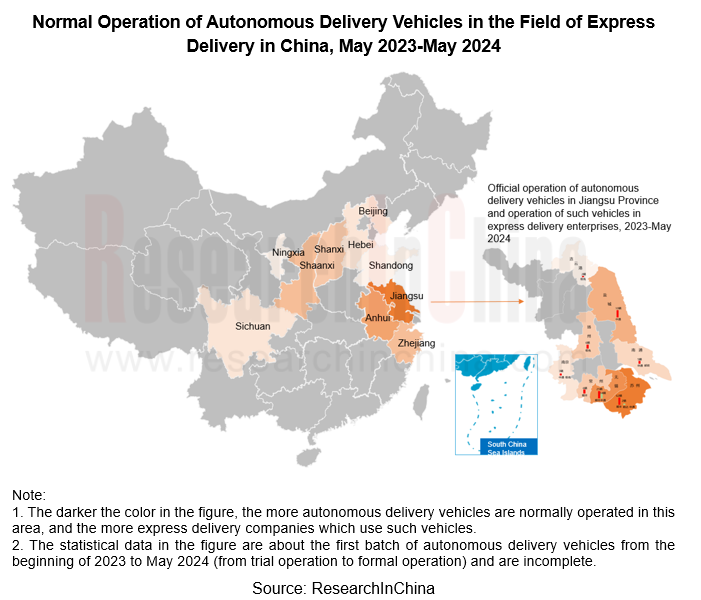
Jiangsu Province has the largest number of autonomous delivery vehicles in normal operation, and Suzhou is the city with the most autonomous delivery vehicles in express delivery enterprises in Jiangsu and even the whole country. In November 2023, Jiangsu took the lead in the country to enact legislation to promote the development of Internet of Vehicles and intelligent connected vehicles: the Standing Committee of the 14th Jiangsu Provincial People's Congress approved the "Decision on Promoting the Development of Internet of Vehicles and Intelligent Connected Vehicles", which made guiding and authoritative provisions on the passage and management of autonomous driving equipment such as autonomous delivery vehicles on roads and came into effect on January 1, 2024. By April 2024, there had been 41 autonomous delivery vehicles in normal operation in Xiangcheng District of Suzhou, delivering about 14,000 parcels every day. Xiangcheng District reached in-depth cooperation with express delivery companies such as SF Express, Yunda Express and STO Express.
The following indicates the normal operation of autonomous delivery vehicles in express delivery enterprises by province:
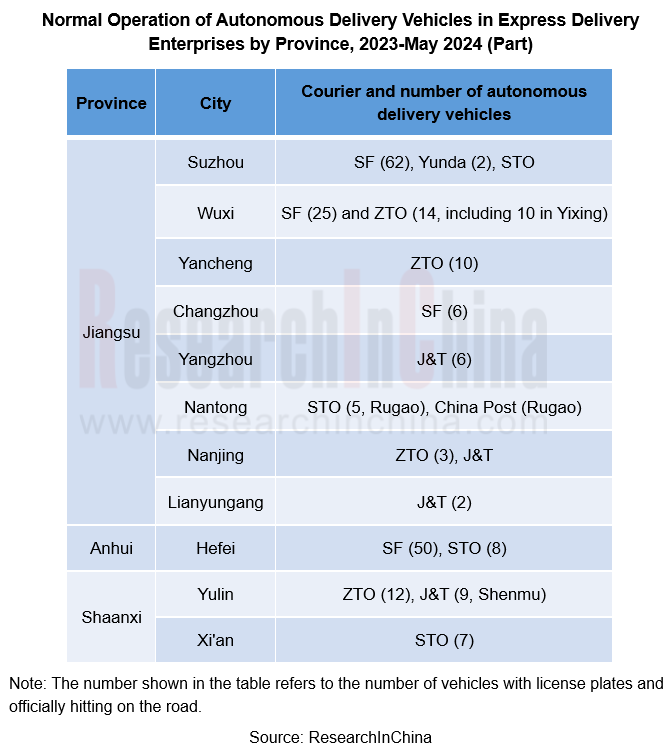
?2. "Outdoor autonomous vehicles + indoor robots" can accomplish autonomous direct delivery to destinations.
?
In June 2023, an "outdoor autonomous vehicles + indoor robots" integrated AI delivery solution was officially launched in the headquarters of China Postal Express & Logistics. The new solution can combine outdoor autonomous vehicles with different indoor robots to directly deliver goods to destinations in a variety of scenarios. For example, outdoor autonomous vehicles contact indoor robots, mailroom staff operate robots to deliver goods to destinations, users can order coffee via WeChat applets which is then delivered by robots, and robots pick up items after users place orders on the WeChat applet of EMS.
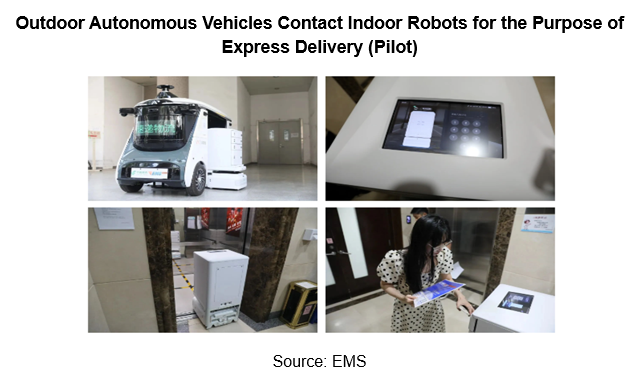
The "outdoor autonomous vehicles + indoor robots" delivery solution mainly relies on the super chassis and super brains of outdoor autonomous vehicles to contact different indoor robots for intensive sharing, wide cooperation and real-time scheduling, while indoor robots have complete perception and cognitive functional components as well as mature positioning and navigation functional components to summon elevators with one key, open electronic doors, pass turnstiles and access Internet of Things.
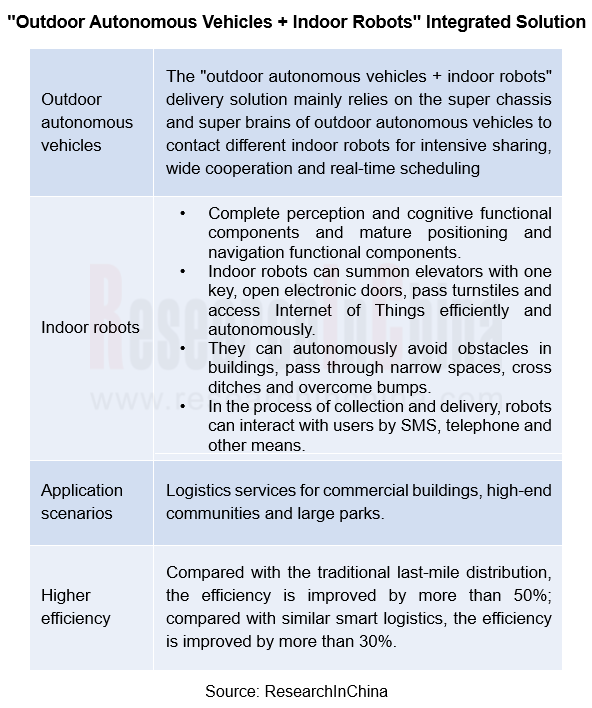
In April 2024, the WeChat applet of EMS launched the robot door-to-door delivery service. On the delivery page of the applet, there is an additional "robot door-to-door" delivery option. In large parks, universities and other places, couriers operate autonomous vehicles to transport parcels downstairs, and them indoor robots automatically "relay" them to destinations.
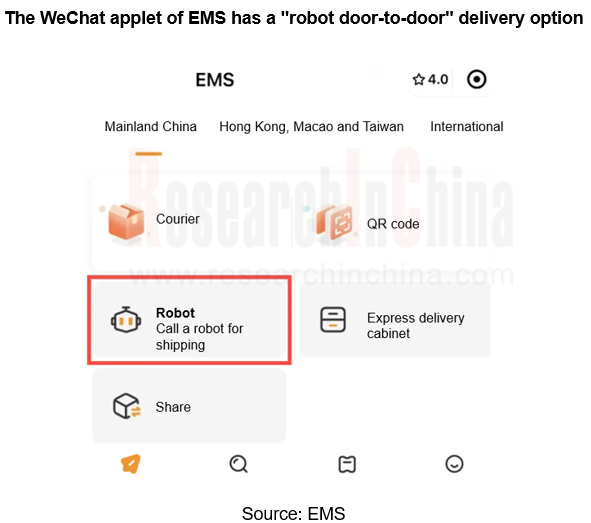
3. Autonomous delivery technology has been rapidly iterated, and BEV+Transformer perception technology has landed on vehicles.
?
The algorithm structure of NEOLIX has gone through three stages, from first stage of light perception and heavy maps, to the second stage of heavy perception and light maps, and to the third stage of real-time map generation based on 4D perception of foundation models.
On the technical level of autonomous driving software, X3 Plus, Neolix’s? autonomous vehicle, strictly follows the underlying technical architecture logic of autonomous driving, adopts the multi-modal BEV space 4D time sequence fusion perception technology, carries Orion-X to realize pre-fusion BEV perception, and leverages the Transformer perception foundation model to process multi-sensor data of continuous time series in real time and realize zero-blind-spot, high-precision and high-robustness environmental perception.
In BEV space, time sequence fusion is carried out to form 4D space. At the same time, complex traffic flow reinforcement learning (TFRL) allows autonomous vehicles to interact with other road participants and predict their future behavior, so as to conduct better planning and control. Neolix’s autonomous driving system has the capability of autonomous learning, so that it can perceive more complex obstacles, handle more complicated roads, and make autonomous delivery easy.
In other words, all the features of 2 lidars and 11 panoramic cameras are converted into the BEV space for fusion, and more comprehensive perception is fulfilled based on the fused features. This system can make full use of the advantages of each sensor, and overcome the corresponding shortcomings, so as to perform perfect perception within a range of 40m front and rear and 30m left and right, and ensure that autonomous vehicles can accurately detect objects and lane lines and recognize traffic lights, thus guaranteeing the driving safety of autonomous vehicles.
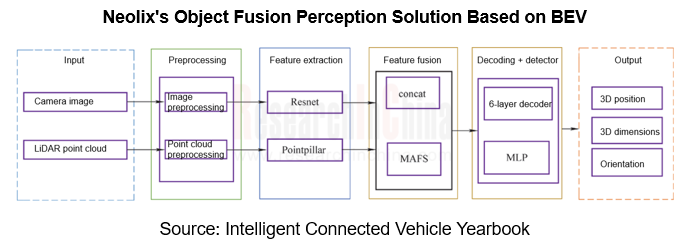
Foreign Tier 1 ADAS Suppliers Industry Research Report 2025
Research on Overseas Tier 1 ADAS Suppliers: Three Paths for Foreign Enterprises to Transfer to NOA
Foreign Tier 1 ADAS suppliers are obviously lagging behind in the field of NOA.
In 2024, Aptiv (2.6...
VLA Large Model Applications in Automotive and Robotics Research Report, 2025
ResearchInChina releases "VLA Large Model Applications in Automotive and Robotics Research Report, 2025": The report summarizes and analyzes the technical origin, development stages, application cases...
OEMs’ Next-generation In-vehicle Infotainment (IVI) System Trends Report, 2025
ResearchInChina releases the "OEMs’ Next-generation In-vehicle Infotainment (IVI) System Trends Report, 2025", which sorts out iterative development context of mainstream automakers in terms of infota...
Autonomous Driving SoC Research Report, 2025
High-level intelligent driving penetration continues to increase, with large-scale upgrading of intelligent driving SoC in 2025
In 2024, the total sales volume of domestic passenger cars in China was...
China Passenger Car HUD Industry Report, 2024
ResearchInChina released the "China Passenger Car HUD Industry Report, 2025", which sorts out the HUD installation situation, the dynamics of upstream, midstream and downstream manufacturers in the HU...
ADAS and Autonomous Driving Tier 1 Suppliers Research Report, 2025 – Chinese Companies
ADAS and Autonomous Driving Tier 1 Suppliers Research Report, 2025 – Chinese Companies
Research on Domestic ADAS Tier 1 Suppliers: Seven Development Trends in the Era of Assisted Driving 2.0
In the ...
Automotive ADAS Camera Report, 2025
①In terms of the amount of installed data, installations of side-view cameras maintain a growth rate of over 90%From January to May 2025, ADAS cameras (statistical scope: front-view, side-view, surrou...
Body (Zone) Domain Controller and Chip Industry Research Report,2025
Body (Zone) Domain Research: ZCU Installation Exceeds 2 Million Units, Evolving Towards a "Plug-and-Play" Modular Platform
The body (zone) domain covers BCM (Body Control Module), BDC (Body Dom...
Automotive Cockpit Domain Controller Research Report, 2025
Cockpit domain controller research: three cockpit domain controller architectures for AI Three layout solutions for cockpit domain controllers for deep AI empowerment
As intelligent cockpit tran...
China Passenger Car Electronic Control Suspension Industry Research Report, 2025
Electronic control suspension research: air springs evolve from single chamber to dual chambers, CDC evolves from single valve to dual valves
ResearchInChina released "China Passenger Car Elect...
Automotive XR Industry Report, 2025
Automotive XR industry research: automotive XR application is still in its infancy, and some OEMs have already made forward-looking layout
The Automotive XR Industry Report, 2025, re...
Intelligent Driving Simulation and World Model Research Report, 2025
1. The world model brings innovation to intelligent driving simulation
In the advancement towards L3 and higher-level autonomous driving, the development of end-to-end technology has raised higher re...
Autonomous Driving Map (HD/LD/SD MAP, Online Reconstruction, Real-time Generative Map) Industry Report 2025
Research on Autonomous Driving Maps: Evolve from Recording the Past to Previewing the Future with "Real-time Generative Maps"
"Mapless NOA" has become the mainstream solution for autonomous driving s...
End-to-End Autonomous Driving Research Report, 2025
End-to-End Autonomous Driving Research: E2E Evolution towards the VLA Paradigm via Synergy of Reinforcement Learning and World Models??The essence of end-to-end autonomous driving lies in mimicking dr...
Research Report on OEMs and Tier1s’ Intelligent Cockpit Platforms (Hardware & Software) and Supply Chain Construction Strategies, 2025
Research on intelligent cockpit platforms: in the first year of mass production of L3 AI cockpits, the supply chain accelerates deployment of new products
An intelligent cockpit platform primarily r...
Automotive EMS and ECU Industry Report, 2025
Research on automotive EMS: Analysis on the incremental logic of more than 40 types of automotive ECUs and EMS market segments
In this report, we divide automotive ECUs into five major categories (in...
Automotive Intelligent Cockpit SoC Research Report, 2025
Cockpit SoC research: The localization rate exceeds 10%, and AI-oriented cockpit SoC will become the mainstream in the next 2-3 years
In the Chinese automotive intelligent cockpit SoC market, althoug...
Auto Shanghai 2025 Summary Report
The post-show summary report of 2025 Shanghai Auto Show, which mainly includes three parts: the exhibition introduction, OEM, and suppliers. Among them, OEM includes the introduction of models a...